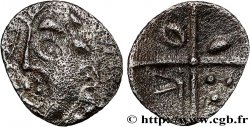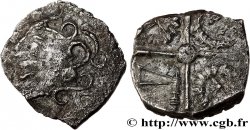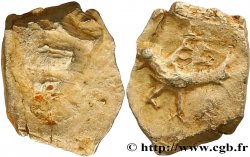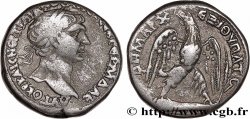v20_0176 - GALLIA - SUDOVESTE DELLA GALLIA - RUTENI (Regione di Rodez) Drachme “du type de Goutrens”
MONNAIES 20 (2004)
Prezzo di inizio : 160.00 €
Valutazione : 300.00 €
Prezzo realizzato : 160.00 €
Numero di offerte : 1
Offerta maxima : 206.00 €
Prezzo di inizio : 160.00 €
Valutazione : 300.00 €
Prezzo realizzato : 160.00 €
Numero di offerte : 1
Offerta maxima : 206.00 €
Tipo : Drachme “du type de Goutrens”
Data: c. 121-52 AC.
Metallo : argento
Diametro : 15,5 mm
Asse di coniazione : 2 h.
Peso : 2,23 g.
Grado di rarità : R1
Commenti sullo stato di conservazione:
Monnaie frappée sur un flan large. Profil en bord de coin au droit, avec la chevelure quasiment complète. Hache complète au revers, mais, les autres cantons sont incomplets
N° nelle opere di riferimento :
Pedigree :
Cette monnaie provient d’une vieille collection et très certainement directement du trésor de Goutrens
Diritto
Titolatura diritto : ANÉPIGRAPHE.
Descrittivo diritto : Tête stylisée à gauche avec les cheveux en forme de S.
Rovescio
Titolatura rovescio : ANÉPIGRAPHE.
Descrittivo rovescio : Croix bouletée, divisée en quatre cantons : rouelle perlée et croisetée aux 1er et 4e cantons, (torque au 2e canton) et hache perlée au 3e canton.
Commento
Taillé au burin. Même coin de revers que les exemplaires décrits par G. Saves, pl. XV, n° 259 et 264. Même coin de revers que les exemplaires de MONNAIES VIII, n° 884, de MONNAIES XV, n° 305 à 307 et de MONNAIES XIX n° 426 ainsi que les exemplaires des musées de Rouen n° 113 et de Zürich n° 93. Tous les exemplaires frappés avec ce coin de revers sont identifiables en raison de la cassure de coin, au centre de la croix, dont on peut suivre l’évolution au fur et à mesure de l’utilisation et des frappes. On peut remarquer une trace de double frappe sous le manche de la hache.
Cut with a burin. Same reverse die as the examples described by G. Saves, pl. XV, nos. 259 and 264. Same reverse die as the examples of COINS VIII, no. 884, of COINS XV, nos. 305 to 307 and of COINS XIX no. 426 as well as the examples of the museums of Rouen no. 113 and Zurich no. 93. All the examples struck with this reverse die are identifiable because of the die break, in the center of the cross, the evolution of which can be followed over time with use and strikes. A trace of double striking can be seen under the handle of the axe
Cut with a burin. Same reverse die as the examples described by G. Saves, pl. XV, nos. 259 and 264. Same reverse die as the examples of COINS VIII, no. 884, of COINS XV, nos. 305 to 307 and of COINS XIX no. 426 as well as the examples of the museums of Rouen no. 113 and Zurich no. 93. All the examples struck with this reverse die are identifiable because of the die break, in the center of the cross, the evolution of which can be followed over time with use and strikes. A trace of double striking can be seen under the handle of the axe








 Segnalare un errore
Segnalare un errore Stampate la pagina
Stampate la pagina Condividi mia selezione
Condividi mia selezione Fai una domanda
Fai una domanda Consegnare / vendere
Consegnare / vendere
 Descrittivo
Descrittivo















